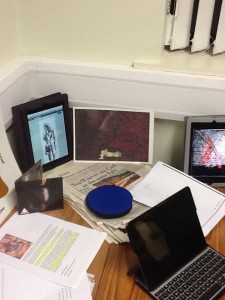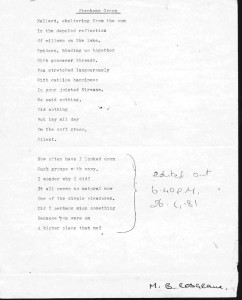One of the unusual results of student led learning is that occasionally, when the students set the homework, the lecturer has to do it. Over the past two weeks, our MA DAH class conducted an exercise in creativity which was new to me, but will become a regular part of our programme.
Several students in the MA DAH class have a background in the arts, one has an IMDB credit, one has released an album and one teaches in the field.
It was this last who suggested to us an exercise which was new to most of us in the room. We were all to bring in something which we had created, introduce them, pile them up as. Collection on the corner, take notes and over the next week produce a piece of creative work in reaction to the collection.
 The resulting collection reflected the diversity of the class and our previous creative work. There was photograph of Nelson Mandela’s visit to Ireland, framed with text, several poems, an album, some very interesting pictures, a diverse selection of journalism. Some of the work was digital, some not, some mixed. I hadn’t finished anything creative for a long time, so I dug in the archives and pulled a poem from over thirty years ago, one of the least embarrassing of my teenage efforts. The version i passed round was a print of a scan from the version typed on an old manual typewriter, on which I edited out a second verse but had never retyped it without the excess words. Makes you wonder how much of the writing process gets lost now that we can just select and delete whole sections of failed drafts.
The resulting collection reflected the diversity of the class and our previous creative work. There was photograph of Nelson Mandela’s visit to Ireland, framed with text, several poems, an album, some very interesting pictures, a diverse selection of journalism. Some of the work was digital, some not, some mixed. I hadn’t finished anything creative for a long time, so I dug in the archives and pulled a poem from over thirty years ago, one of the least embarrassing of my teenage efforts. The version i passed round was a print of a scan from the version typed on an old manual typewriter, on which I edited out a second verse but had never retyped it without the excess words. Makes you wonder how much of the writing process gets lost now that we can just select and delete whole sections of failed drafts.

We took notes, but mostly we took digital pictures of the collection, and went off to produce creative pieces in reaction to to collection over the next week. I didn’t take notes then, but I did start dropping notes into a mind map on my iPad later in the week. Sadly, those notes were not coalescing into a poem, or anything I could pass off as one. As the deadline moved from creeping up to racing up, and determined that I was not going to use the excuse of “teacher doesn’t have to do the class homework”, I took to the blackboard in my office to write. It didn’t work at all, and I fell back on my yellow legal pad. I wrote a page, tore it off, started at the to and rewrote on a second page, and then repeated it on a third page at which point with a bit of editing, I decided it was done, and I should stop.
But it wasn’t done, because when I typed it into a quick email to send round, I cut out more words as I typed. The end product was this
Green water of memories
souls deep
washing up the corner
roiling back the room
sparkling foamy life
slicing the hollow wave edge
surfing outside your souls
carving empty mindfulness
which actually fairly obviously picks up both physical elements of how we assembled the collection, some of the colours I got out of pieces in the collection, waves and stuff – there was some Emily Dickinson, lighthouse stuff floating round the class, and also says some stuff about my relationship to the class, which is more intellectual rather than emotional.
I had hoped to produce something more – I had had visions of backing the words with some art, and gargaebanding some ocean sounds into an ambient soundtrack, but that was all beyond the time I had available. Armed with this good old non-rhyming, non-scanning poetry and a sizeable dose of self-satisfaction. I headed to class and found a range of diverse responses to the collected works of the previous week.
There was a cake. Inspired by the colours and images, the class baker produced a magnificent cake, carefully crafted flowers which would not have looked out of place on ‘Ace of Cakes’
There was a long form essay, some very visual poetry, a sound piece and a print which took in almost all of the collection pieces, and rendered them in a very complex complex screen print, a beautiful piece of cyanography, and several other pieces of work which I hope the various folks in the class will blog about.
What was striking was the range of methods used to produce the creative responses, and the ways in which digital and traditional methods came together. Most of the pieces involved some cross-over between old and new tools, and the best were the ones, I think, which most effectively bridged old physical and new digital tools to create work. It adds interest, in a term when we are reading classics like Walter Benjamin and Baudrillard, to actually engage with doing something creative that involves digital tools. We’ll do this again every year in the MA in DAH, and we might experiment with more than once in the year, so the second iteration can be in a shorter timeframe in a more workshop setting so explore what we might discover from working more closely together.




Leave a Reply